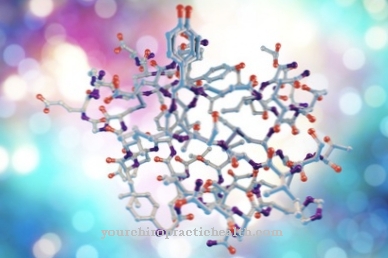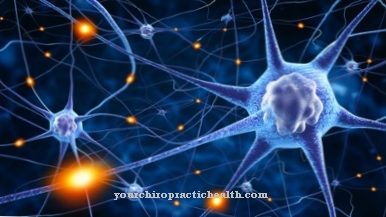Of the Brokken-Wiersinga-Prummel control loop is within the thyrotropic control loop an activated feedback loop from TSH on its own formation. The TSH formation is limited with the aid of this control loop. It is important for the interpretation of the TSH level in Graves' disease.
What is the Brokken-Wiersinga-Prummel control loop?

The Brokken-Wiersinga-Prummel control circuit is an ultra-short feedback mechanism for the TSH level on the TSH release. The more TSH is released, the more TSH formation is inhibited. However, it is a downstream control loop within the thyrotropic main control loop.
TSH is a proteinogenic hormone called thyrotropin. Thyrotropin is produced in the pituitary gland and controls the formation of the thyroid hormones thyroxine (T4) and triiodothyronine (T3). The two hormones stimulate the metabolism. If their concentration is too high, it leads to hyperthyroidism (overactive thyroid) with accelerated metabolic processes, palpitations, sweating, tremors, diarrhea and weight loss.
In the opposite case, there is an underactive thyroid (hypothyroidism) with the slowdown of all metabolic processes and weight gain. The main control circuit has the effect that when the T3 and T4 concentration increases, the thyrotropin release is reduced via negative feedback.
In addition to the thyrotropic main control loop, there are further secondary control loops. This includes the Brokken-Wiersinga-Prummel control loop as an ultra-short feedback mechanism, which additionally limits the TSH synthesis.
Function & task
The biological importance of the Brokken-Wiersinga-Prummel control loop is in all probability to prevent excessive TSH release. It ensures a pulse-like fluctuation in the TSH level.Overall, the processes within the thyrotropic control loop are complicated and, due to their complexity, require several downstream control loops. In addition to the ultrashort feedback mechanism, there is also the long feedback of the thyroid hormones on the release of TRH (thyrotropin releasing hormone) and control circuits for adjusting the plasma protein binding of T3 and T4.
In addition, the TSH level is linked to the activity of deiodinases, which convert the inactive T4 into the activated T3. The thyrotropic main control loop also includes the activity of TRH (thyrotropin releasing hormone). The thyrotropin releasing hormone is released in the hypothalamus and regulates the formation of TSH. With the help of this hormone, the hypothalamus produces the setpoint it specifies for the thyroid hormones. To do this, it constantly determines the actual value. The setpoint must be in a reasonable relationship to the corresponding physiological conditions.
When the need for thyroid hormones increases, the production of TRH is stimulated, which in turn stimulates the production of TSH. Elevated TSH levels produce more of the thyroid hormones T4 and T3. The deiodinases have to be activated in order to cause a conversion from T4 to T3.
In addition, iodine uptake is regulated by TSH. However, it is also subject to its own iodine-dependent regulation. T4 gives the most important feedback for the synthesis of TSH. T3 works only indirectly by binding to a thyrotropin receptor or a receptor for TRH.
The secretion of TSH is thus influenced by TRH, the thyroid hormones and also by somatostatin. Furthermore, neurophysiological signals also influence the formation of TSH. Via the downstream Brokken-Wiersinga-Prummel control circuit, the TSH concentration is also limited by its own TSH release. This is probably done via the peptide hormone thyroid stimulin.
The function of this hormone is currently unknown. Like TSH, it docks to the TSH receptor and seems to have a similar effect. It may therefore play a mediating role in the Brokken-Wiersinga-Prummel control loop. However, these complex relationships do not allow a simple correlation between the concentrations of TSH and the thyroid hormones.
Illnesses & ailments
The complex relationship becomes particularly clear in the treatment of hyperthyroidism and hyperthyroidism. An underactive thyroid (hypothyroidism) can be caused by several causes, such as destroyed thyroid tissue, missing thyroid, lack of TSH due to hypophysis or lack of TRH due to hypothalamus. An overactive thyroid (hyperthyroidism) can result from autoimmune diseases of the thyroid, from tumors that produce TSH or from excess TRH. These diseases lead to the fact that the thyroid control circuit can no longer function properly.
The importance of the Brokken-Wiersinga-Prummel control loop is particularly evident in the so-called Basedow's disease. Here the relationship between the concentrations of TSH and the thyroid hormones no longer corresponds. Graves' disease is characterized by an overactive thyroid gland caused by autoimmune reactions. As part of this disease, the immune system attacks the receptors for TSH in the follicle cells of the thyroid gland. These are antibodies of the IgG type that bind to the TSH receptor. These autoantibodies permanently stimulate the receptors and thus imitate the natural effects of TSH. The permanent stimulation also leads to the permanent formation of thyroid hormones. A growth stimulus is initiated by thyroid tissue so that it becomes larger as one grows (goiter).
The existing TSH is no longer effective because it cannot bind to the receptors. Due to the increased levels of thyroid hormones, the concentration of TSH becomes even lower. This effect is also reinforced by the fact that the autoantibodies also act directly on the pituitary gland and thereby hinder the release of TSH. Despite the low TSH concentration, Graves' disease is hyperthyroid. The antibodies also attack the retroorbital eye muscles, so that the eyes can protrude. Diagnostically, increased values for the thyroid hormones T3 and T4 and suppressed values for TSH can be determined. This correlation is typical of Graves' disease.
There is usually a connection between elevated thyroid levels and elevated TSH levels.
















.jpg)
.jpg)



.jpg)






